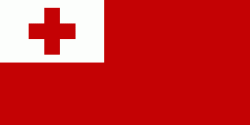Ha'apai (Ha‘apai)
Haʻapai is a group of islands, islets, reefs, and shoals in the central part of Tonga. It has a combined land area of 109.30 sqkm. The Tongatapu island group lies to its south, and the Vavaʻu group lies to its north. Seventeen of the Haʻapai islands are inhabited. Their combined population is 5,419. The highest point in the Ha‘apai group, and in all of Tonga, is on Kao, which rises almost 1050 m above sea level.
The administrative capital village of Haʻapai District is Pangai, which is located on Lifuka.
Haʻapai comprises 51 islands that lie directly west of the Tonga Trench. They constitute a chain of both volcanic and coral islands, including Kao, the highest point in the kingdom, which stands 1046 m high. Farther to the east are the coral islands, which are inhabited. The Haʻapai archipelago lies 204 km north of Tongatapu and 130 km south of Vavaʻu. Seventeen of the islands are inhabited, including the main islands of Lifuka and Foa. The two main villages in the archipelago are Pangai on Lifuka (where Salote Pilolevu Airport is located) and Ha'ano. A total of 6125 people live on the Ha'apai islands (Census 2016 ).
All of the larger islands of Haʻapai are in the eastern Lifuka group. The two largest islands are Lifuka and Foa which in 2016 had recorded populations of 2,205 and 1,392 people respectively. The next largest are Nomuka and Haʻano, which have four villages, with a combined population of 910. To the south of these islands is ʻUiha, which has two villages with a combined population of 695. ʻUiha is also the site of ancient burial grounds and an ancient monument.
The large islands of Tofua (an active volcano) and Kao (a dormant volcano) are in the far west. The islands of the Kotu group, locally known as Lulunga, are in the southwest of the archipelago. The islands of the Nomuka group, locally known as ʻOtu Muʻomuʻa, are farther south. The Hunga Tonga–Hunga Ha'apai volcano is located in the southwest of Haʻapai.
Humpback whales migrate to the area during their “wintering” seasons.
The administrative capital village of Haʻapai District is Pangai, which is located on Lifuka.
Haʻapai comprises 51 islands that lie directly west of the Tonga Trench. They constitute a chain of both volcanic and coral islands, including Kao, the highest point in the kingdom, which stands 1046 m high. Farther to the east are the coral islands, which are inhabited. The Haʻapai archipelago lies 204 km north of Tongatapu and 130 km south of Vavaʻu. Seventeen of the islands are inhabited, including the main islands of Lifuka and Foa. The two main villages in the archipelago are Pangai on Lifuka (where Salote Pilolevu Airport is located) and Ha'ano. A total of 6125 people live on the Ha'apai islands (Census 2016 ).
All of the larger islands of Haʻapai are in the eastern Lifuka group. The two largest islands are Lifuka and Foa which in 2016 had recorded populations of 2,205 and 1,392 people respectively. The next largest are Nomuka and Haʻano, which have four villages, with a combined population of 910. To the south of these islands is ʻUiha, which has two villages with a combined population of 695. ʻUiha is also the site of ancient burial grounds and an ancient monument.
The large islands of Tofua (an active volcano) and Kao (a dormant volcano) are in the far west. The islands of the Kotu group, locally known as Lulunga, are in the southwest of the archipelago. The islands of the Nomuka group, locally known as ʻOtu Muʻomuʻa, are farther south. The Hunga Tonga–Hunga Ha'apai volcano is located in the southwest of Haʻapai.
Humpback whales migrate to the area during their “wintering” seasons.
Map - Ha'apai (Ha‘apai)
Map
Country - Tonga
 |
 |
| Flag of Tonga | |
First inhabited roughly 2,500 years ago by the Lapita civilization, Tonga's Polynesian settlers gradually evolved a distinct and strong ethnic identity, language, and culture as the Tongan people. They were quick to establish a powerful footing across the South Pacific, and this period of Tongan expansionism and colonization is known as the Tuʻi Tonga Empire. From the rule of the first Tongan king, ʻAhoʻeitu, Tonga grew into a regional power. It was a thalassocracy that conquered and controlled unprecedented swathes of the Pacific, from parts of the Solomon Islands and the whole of New Caledonia and Fiji in the west to Samoa and Niue and even as far as parts of modern-day French Polynesia in the east. Tuʻi Tonga became renowned for its economic, ethnic, and cultural influence over the Pacific, which remained strong even after the Samoan revolution of the 13th century and Europeans' discovery of the islands in 1616.
Currency / Language
| ISO | Currency | Symbol | Significant figures |
|---|---|---|---|
| TOP | Tongan paʻanga | T$ | 2 |
| ISO | Language |
|---|---|
| EN | English language |
| TO | Tongan language |















